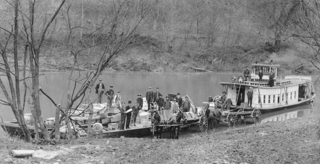 | Back to e-WV
| Back to e-WV
 The West Virginia Encyclopedia
The West Virginia Encyclopedia
 | Back to e-WV
| Back to e-WV
 The West Virginia Encyclopedia
The West Virginia Encyclopedia

The Little Kanawha River enters the Ohio River at Parkersburg, 169 miles from its beginning near Craddock, Upshur County. As it flows westward through Braxton, Gilmer, Calhoun, Wirt, and Wood counties, the Little Kanawha gathers water from numerous creeks and streams. Its largest tributary is the Hughes River.
Indians had left the Little Kanawha before the time of European-American exploration, but a small band under Chief Bull settled there in 1765, just as settlers of European descent were entering the area. They lived near the salt licks at the community now called Bulltown. Many of them were massacred by men of European descent in 1772 and their bodies thrown into the river. The upper watershed was explored by John Hacker in 1770. The pioneering Carpenter family settled in the region shortly thereafter. The Bulltown area was settled by European-American men in the 1770s, with settlement at Parkersburg soon following. Eventually, the communities of Burnsville, Gilmer Station, Glenville, Elizabeth, Grantsville, and Creston would also be established along the Little Kanawha.
In 1838, Claudius Crozet, the director of the Virginia Board of Public Works, recommended that 10 locks and dams be constructed to permit navigation on the Little Kanawha from Parkersburg to Bulltown salt works. The Little Kanawha Navigation Company began selling stock in 1847, and the reorganized company finally let contracts for the first four locks and dams in 1867. By 1874, boats could travel from Parkersburg upriver past Palestine, Wirt County. These were private locks owned by the company. In 1891, the ‘‘government lock’’ was built near Burning Springs. The remaining locks recommended by Crozet were never built, but these five were sufficient to enable shallow-draft riverboats access all the way to Burnsville.
From the mid-1800s and into the 1930s, boats powered by steam and later by gasoline carried people, mail, and freight up and down the river. The boats that plied the Little Kanawha were much smaller than the big paddle wheelers that churned the Ohio River. A windowed cabin, sometimes two decks tall, protected passengers and freight from the weather. Divided into rooms and a galley, the cabin was home to the crew, which sometimes included the family of the captain. A wheelhouse perched atop the whole. Commercial navigation came to an end as roadways connecting the towns along the river’s banks improved.
The West Virginia oil and gas industry developed within the Little Kanawha watershed. The state’s first oil well and one of the very earliest in the world was drilled at Burning Springs in 1860. The Burning Springs oil field was fired by Confederate raiders in 1863, creating an inferno so intense that oil burned on the surface of the river.
Burnsville Dam was built on the upper reaches of Little Kanawha in 1978, providing flood control and recreation.
Written by Joy Gregoire Gilchrist-Stalnaker
. Hackers Creek Pioneer Descendants, Horner.
Gilchrist, Joy Gregoire. It was Crowded up There. Goldenseal, (Summer 1994).
Sypolt, Larry & Emory Kemp. The Little Kanawha Navigation. Canal History and Technology Proceedings, (1991).
Murphy, James M. "Transportation on the Little Kanawha River." M.A. thesis, West Virginia University, 1950.